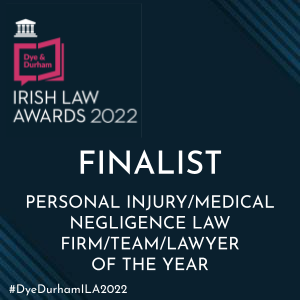INSTRUCTING A BIRTH INJURY SOLICITOR
For most people, pregnancy and giving birth is one of the happiest times of their lives. However, if things go wrong, it can be a very traumatic time for parents. Birth injury claims involve children who are injured during the course of labour, delivery and in the neonatal period. They are some of the most tragic, emotional and distressing types of medical negligence cases that come before the Courts.
By instructing our team of birth injury solicitors, compensation from a successful claim can help to pay for the necessary care and therapy needs of the child.
NEGLIGENCE
In order to succeed in a birth injury* claim, it will be necessary to prove that a duty of care existed. There must have been a breach of that duty of care and a causal connection between the breach of that duty and the resultant injury, loss or damage.
It is vital to engage an appropriate expert, such as an obstetrician or neonatologist to furnish their opinion on whether the care provided fell below an acceptable standard resulting in a breach of duty.
Once a breach of duty has been established, the next steps are to prove that an injury occurred and that there is a connection between that breach of duty and the injury sustained. This will typically require reports and opinions from a number of specialists including experts in obstetrics, neonatology, paediatric neurology and paediatric neuroradiology.
IMMEDIATE STEPS TO TAKE
1. Speak to a solicitor
If you are over 18 years old, you only have 2 years less 1 day to lodge a claim from the date of incurring your injury (there are some limited exceptions to this rule). Therefore, you should quickly make contact with a solicitor who can then advise you whether or not you might have a claim.
If the claimant is a child, then a parent or guardian can issue proceedings at any time up until the child’s 18th birthday. Thereafter, the young adult has 2 years less 1 day to bring a spinal injury claim in their own right.
2. Make a note of the incident
If they can, is advisable for the parent(s), to write down all the details that they can recall.
A note should be made of the following:
- Any issues during the course of the pregnancy
- The timings of the labour events
- The baby’s condition at the birth
This can be a particularly difficult exercise to do after experiencing such a traumatic event, but it will be of tremendous benefit to your potential new solicitors. It will assist them with the process of taking your formal instructions.
3. Obtain the mother & child’s medical records
Another step you can take to possibly speed up the early stages of the investigation is to obtain all of the obstetric & neonatal medical records, radiology and reports from the hospitals and care providers attended (including GP records). Information on how to obtain those records will be available on the hospitals websites.
OUR APPROACH
Our team of experienced birth injury* solicitors will review the set of obstetric/neonatal records. We will see if there might be evidence available to link the child’s injury to intrapartum events, for example, so as to justify commencing a pre-action investigation. We would usually be looking out for the following:
- Evidence of foetal distress in labour
- An acute intrapartum event e.g. placental abruption
- The cord blood pH
- Condition at birth (Apgar score)
- Requirement for resuscitation or breathing support
- Blood transfusions
- Neonatal hypoglycemia
- Encephalopathy in the first 72 hours of life
- Evidence of hypoxic-ischemic injury
- Evidence of a PVL injury
- Evidence available from radiological investigations including MRI scanning
HOW TO BRING A CLAIM
Read more about the legal steps that are involved in bringing a catastrophic birth injury claim.
Contact Us
Looking for help? Call us on 01 6770044 or email us at info@rmcm.ie
WHAT IS A BIRTH INJURY*?
There are several types of birth injuries, including neurological and physical injuries. These injuries can commonly occur as a result of complications during pregnancy, labour, or childbirth. Birth can be temporary or can result in extensive and long-term damage.
Typical injuries that lead to a birth injury compensation claim are often related to the baby not receiving sufficient oxygen during or just before delivery. This can be caused by inadequate monitoring, failure to diagnose a condition, the mother experiencing complications during the birth or improper handling of the baby once it is born. A reduction in the supply of oxygen to the brain may cause brain damage or lead to some other form of permanent disability, such as cerebral palsy.
Medical negligence can cause several types of birth injuries. The following are examples of birth injuries* that can lead to claims for compensation.
Cerebral Palsy*
The development of cerebral palsy is one of the most serious types of birth injury* that a child can develop. The term cerebral palsy is used to describe a medical condition that affects control of the muscles. Due to an injury* to the brain, the sufferer is unable to use some of the muscles in their body in the normal way. There are different types of cerebral palsy including spastic quadriplegia or hemiplegia, dyskinetic cerebral palsy, hypotonic or ataxic cerebral palsy.
Cerebral palsy is caused by an injury* to the brain before, during, or shortly after birth. Problems during birth, such as the baby not getting enough oxygen, or a difficult delivery in which the baby’s brain is injured may result in cerebral palsy.
Some babies born with cerebral palsy do not show obvious signs right away. Classically, cerebral palsy becomes evident when the baby does not reach developmental milestones and where preferential use of limbs, asymmetry or gross motor developmental delay is seen.
Neonatal Encephalopathy and Hypoxic Ischaemic Encephalopathy (HIE)
Neonatal encephalopathy is an umbrella term to describe disturbed neurological function in a newborn baby. Some indicators may include respiratory distress, a low Apgar score, acidic blood PH, abnormal muscle tone (stiff or floppy in appearance), seizure activity, depressed reflexes, feeding problems etc.
Hypoxic ischaemic encephalopathy (HIE) is the most common type of neonatal encephalopathy. HIE is a neonatal brain injury caused by oxygen deprivation (hypoxia) and a limited blood flow to the brain (ischemia) at or near the time of birth. The brain does not receive adequate oxygenation, which leads to cell death and subsequent brain damage.
HIE can be the cause of a number of disabilities and impairments, including cerebral palsy, seizure activity, delayed development, cognitive impairment and recent research shows that it may cause neurosensory and neurobehavioral difficulties.
Neonatal encephalopathy and HIE can be caused by a number of medical complications around the time of birth, including:
- Placental or uterine complications e.g. a placental abruption, placenta previa, uterine rupture etc.
- Umbilical cord complications
- Mismanagement of a high risk pregnancy
- Improper fetal heart rate monitoring
- Failing to perform an emergency caesarean section when the labour is prolonged
- Maternal infections which are not managed
- Premature birth
- Mismanagement of the neonatal condition
HIE can be managed using a treatment called neonatal therapeutic hypothermia (cooling treatment). The infant’s brain and/or body is cooled below normal temperatures to help prevent or limit or prevent further damaging inflammation in the brain.
The current guidelines are such that neonatal therapeutic hypothermia must commence within 6 hours of birth, however, there is evolving research which suggests that it may be beneficial when commenced within a 24 hour window from the time of birth.
Furthermore, supportive care should be provided to assist the baby with breathing, to prevent seizure activity and to control blood sugar levels.
Neonatal Hypoglycemia*
Neonatal hypoglycemia is an abnormally low level of blood glucose which can cause long-term brain damage.
It can be caused by a number of issues including, poor nutrition for the mother during pregnancy, poorly controlled maternal diabetes, birth asphyxia (lack of oxygen at birth), birth defects, congenital metabolic diseases or hormone deficiencies, infection etc.
In the case of neonatal hypoglycemia, the baby may require glucose given through an IV. The baby’s blood glucose levels should be regularly monitored.
Brachial Palsy*
Brachial Palsy (Erb’s palsy) occurs when the brachial plexus (the group of nerves that supplies the arms and hands) is injured. It is common when there is difficulty delivering the baby’s shoulder, called shoulder dystocia. The baby loses the ability to flex and rotate the arm. Brachial plexus injuries* can result in lifelong physical disability.
Fractures*
A fracture of the clavicle or collarbone is the most common fracture during labour and delivery. The clavicle may break when there is difficulty delivering the baby’s shoulder or during a breech delivery.
Caput Succedaneum*
Caput is a severe swelling of the soft tissues of the baby’s scalp that develops as the baby travels through the birth canal.
Facial Paralysis*
During labour or birth, pressure on the baby’s face may cause the facial nerve to be injured. This may also occur with the use of forceps for delivery. The injury is often seen when the baby cries when there is no movement on the side of the face and the eye cannot close.
Hip Dysplasia*
This relates to a problem with the formation of the hip joint. The location of the problem can be either the ball of the hip joint (femoral head), the socket of the hip joint (the acetabulum), or both.
Many of the common types of birth injuries can be prevented when proper medical protocol is adhered to.
If a hospital is negligent in their handling of a birth which leads to a baby developing any of the other birth injuries listed above, then an action for medical negligence may arise.
LAURALYNN
Ireland’s Children’s Hospice
“I have come to know Ralph McMahon as a completely trustworthy and honest friend, totally committed to whatever task with which he becomes involved. During my years as chairman of the Children’s Sunshine Home I enjoyed valuable benefit from being able to discuss plans and challenges with Ralph knowing that our conversations would be in total confidence. I appreciated and respected his practical views and comments knowing them to be given sincerely and as a result of clear and conscientious thought.”
George Balmer, Former Chairman of LauraLynn
![]()
1. Instruct a solicitor:
You should get in touch a specialist solicitor who will take your instructions (details of the injury, details of the birth, medical details, details of the history of pregnancy etc.). They will then advise if it might be worthwhile pursuing a claim for compensation.
It is important to note that an adult claimant only has 2 years less 1 day from the date of injury to issue proceedings in court (there are some limited exceptions to this).
When claiming on behalf of a child, a parent or guardian can issue proceedings at any time up until the child’s 18th birthday. Thereafter, the young adult has two years to bring a birth injury claim in their own right.
2. Liability & causation report(s):
Your solicitor will obtain at least one medical expert report to establish whether the injury arose as a result of the hospital’s or care provider’s negligence. The speciality of the medical expert will depend on the nature of the injury. You may require multiple reports from a range of doctors including an obstetrician, a neuroradiologist and a neonatologist.
3. Issue court proceedings:
Once your solicitors have obtained at least one supportive liability and causation report, they can issue court proceedings. Proceedings for catastrophic birth injury claims are typically issued in the High Court.
More information:
See here for more information on how a birth injury claim is made
The timeframe for resolving a birth injury* claim is not exact as each claim is unique both in terms of the nature of the injury itself and how it arose. Very generally, a birth injury case may take in the region of 3 – 5 years to resolve.
However, the timeframe is dependent on the complexity of how the injury arose and it also often depends on the age of the child. If the child is very young, it might be necessary to wait a few years to see what impact the injury has on the child’s developmental milestones.
Broad Claim Timeframes
Initial Investigation:
Unknown timeframe.
Statute of Limitations:
An adult claimant only has 2 years less 1 day from the date of injury to issue proceedings in court (there are some limited exceptions to this).
When claiming on behalf of a child, a parent or guardian can issue proceedings at any time up until the child’s 18th birthday. Thereafter, the young adult has two years to bring a birth injury claim in their own right.
When claiming on behalf of a child, a parent or guardian can issue proceedings at any time up until the child’s 18th birthday. Thereafter, the young adult has two years to bring a birth injury claim in their own right.
Legal Proceedings:
Unknown timeframe.
More Information
See here for more information on how long a birth injury claim takes in Ireland.
Compensation will generally comprise of General Damages and Special Damages.
After obtaining the appropriate quantum expert reports, your solicitors & counsel will be able to advise on the value of the claim.
General Damages
This is compensation for the pain, suffering and inconvenience the claimant experienced and will continue to experience as a result of the injury.
The gravity of the injuries will be considered when assessing the level of general damages to be awarded.
Special Damages
This is compensation for the financial costs and expenses, both past and future, the claimant incurred and will incur as a result of the injury.
In the case of sustaining a catastrophic birth injury, the special damages will make up the bulk of the claim for compensation.
Special damages include medical costs (past & future), loss of earnings and future loss of earnings, past and future nursing care and home help, the cost of housing adaptions, the purchase of specialist equipment, additional expenses etc.



